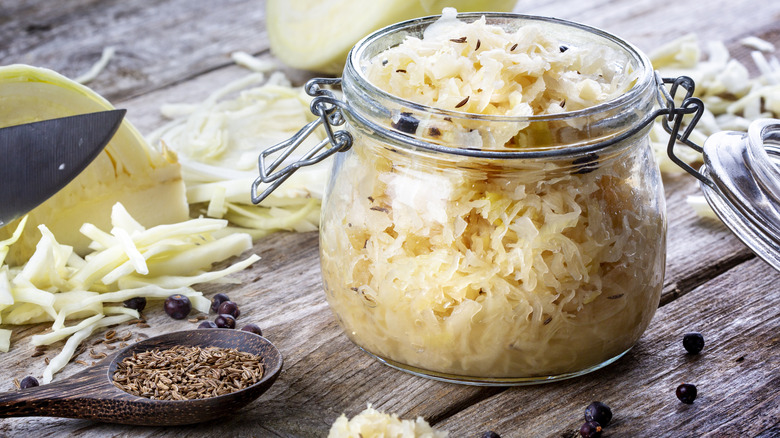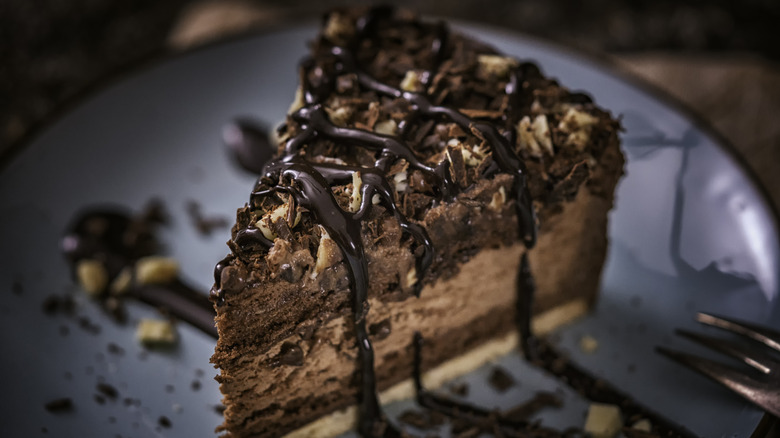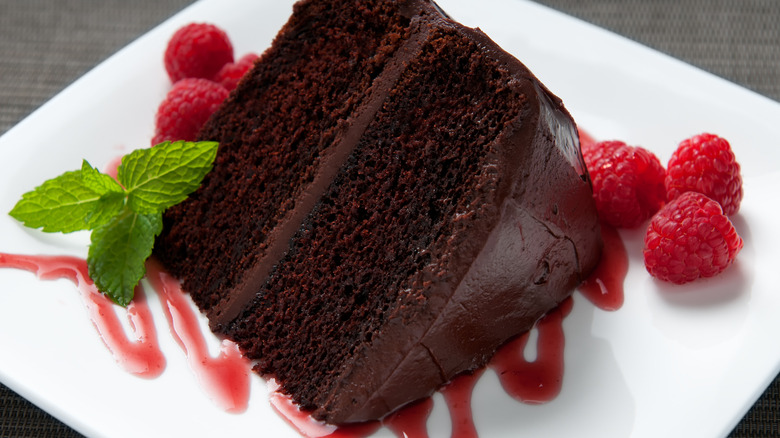Put Some Sauerkraut In Your Next Cake And Thank Us Later
As the first bite hits your lips, the moist, perfect crumb gives way to chocolate overload. You might think that the flavor is from grandma's love, but the secret ingredient might have actually been the condiment on that brat from last night's dinner. Adding sauerkraut to a chocolate cake is a baking hack that needs to be tried.
Although the concept might sound like a Food Network baking challenge, sauerkraut in a chocolate cake recipe is not a new concept. Like many food ideas, the origin story can be debated, but a common theme ties them together: the idea of being born out of necessity.
According to a 1972 article in the Santa Cruz Sentinel, Mrs. Geraldine Timms, lunchroom supervisor of Waller High School in Chicago, was tasked with creating a dish that used surplus sauerkraut. Without adding a pungent note to the dessert, the fermented cabbage gives moistness to the cake's texture. Even though the liquid is drained from the vegetable, the ingredient needs to be finely chopped so that it melds into the batter and almost disappears. No one wants to have a heaping forkful of cabbage on top of icing.
While the parable about necessity being the mother of invention does not always apply in the kitchen, sauerkraut in a chocolate cake might be an exception. It could be an excuse to enjoy some pickled cabbage more frequently.
Why does sauerkraut make for such a moist cake?
While cooking might be part art, baking is a science. The carefully measured ingredients combine in perfect ratios to make a tender, moist cake. In addition, some of the ingredients must react during the baking process. For example, baking soda combined with an acid creates carbon dioxide, which can make for a light, airy crumb when the cake batter is baked. While some common baking acids are buttermilk, sour cream, or yogurt, sauerkraut is another example.
Although some people might have concern that the pungent, briny sauerkraut flavor would overpower the rich, luscious chocolate, that notion should be pushed off the plate. Since many recipes drain most of the pickling liquid and finely chop the sauerkraut, the flavor melds into batter. There can be a slight textural component, similar to the coconut in a German chocolate cake or even pineapple in a carrot cake. But, this cake recipe is not like the side of kraut on a sausage. As long as the sauerkraut is properly prepped, it should be minimally noticeable when taking that first bite.
Still, bakers do need to use caution when adding this ingredient. Similar to how proper measurements should be employed in all baking recipes, no one wants to over-add the pungent ingredient. Ratios in baking might be the real secret ingredient to the perfectly moist cake.
Savory ingredients can make for a more flavorful cake
While sauerkraut might be a challenge for some bakers, other savory ingredients have been a favorite in baking. From using the garden's bounty of zucchini in bread to jalapeños in cornbread, that punch of flavor can help to balance out the sweetness. Although it is not necessarily a similar contrast like salt and sugar, there can be something said about adding a little savory to the butter, sugar, and flour.
Mayonnaise has long been a popular cake ingredient. Although Portillo's might be a favorite with its chocolate cake, the dollop of mayonnaise has been a baking hack used in many kitchens. From a scratch recipe to the boxed mix, the condiment helps to maintain moisture and a light, airy texture.
Stepping outside of the condiment aisle, tomato soup is a secret known to some bakers. Often used in a spice cake, the tomato soup is swapped for the oil. While it can reduce the recipe's fat content, it boosts both the cake's flavor and color.
The next time baking inspiration hits, your pantry might call for some sauerkraut along with that cup of sugar.


